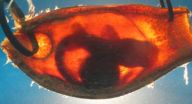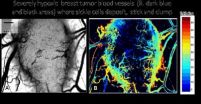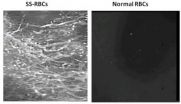(Press-News.org)
URBANA – Perennial biofuel crops such as miscanthus, whose high yields have led them to be considered an eventual alternative to corn in producing ethanol, are now shown to have another beneficial characteristic–the ability to reduce the escape of nitrogen in the environment. In a 4-year University of Illinois study that compared miscanthus, switchgrass, and mixed prairie species to typical corn-corn-soybean rotations, each of the perennial crops were highly efficient at reducing nitrogen losses, with miscanthus having the greatest yield.
"Our results clearly demonstrate that environmental nitrogen fluxes from row-crop agriculture can be greatly reduced after the establishment of perennial biofuel crops," said U of I postdoctoral research associate Candice Smith. "Because of the establishment variability, we were able to compare annual row crops with perennial crops. Although in the first two years, nitrate leaching remained high in the non-established miscanthus crop, once a dense, productive crop was established in the second year of growth, nitrate leaching in tile drainage quickly decreased."
Smith said that this ability to reduce the loss of nitrogen into the environment will prove to be greatly beneficial.
"Intensive corn production with large fertilizer inputs leads to large losses of nitrogen into the environment, both through gas emissions of nitrous oxide and leaching of nitrate to surface waters through tile drainage systems," added Mark David, U of I biogeochemist. "Nitrous oxide is a greenhouse gas, and nitrate can contaminate drinking water supplies and leads to coastal ocean problems. The hypoxic zone that forms each summer in the Gulf of Mexico is a result of nitrate leaching from the tile-drained Corn Belt of the midwestern United States – a likely location for biofuel production," he said.
In the study, funded by the Energy Biosciences Institute, miscanthus, switchgrass, and mixed prairie species were compared against a typical corn-corn-soybean rotation. Harvested biomass and nitrogen, nitrous oxide emissions, and nitrate leaching in the mid-soil profile and through tile drainage lines were all measured.
The researchers found that the perennial crops quickly reduced nitrate leaching in the mid-soil profile as well as from tile lines. "By year four each of the perennial crops had small losses," Smith said. "Nitrous oxide emissions also were much smaller in the perennial crops--including switchgrass, which was fertilized with nitrogen, while prairie and miscanthus were not. Overall, nitrogen levels were higher for the corn and soybean treatment as well as switchgrass, but were lower for prairie and miscanthus. Prairie and miscanthus levels were lower due to harvest of the plant biomass (and nitrogen) each winter, with no fertilizer nitrogen additions to replace it, as occurred in corn and switchgrass," she said.
David added that the miscanthus and mixed prairie also had very wide carbon-to-nitrogen ratios in the harvested material -- as much as 257 to 1 for miscanthus. "Miscanthus efficiently moved nitrogen from leaves to root and rhizome systems after the growing season, where it could be used again the next year," David said. "The lower nitrogen level suggests that the small amount of nitrogen removed by harvest in prairie and miscanthus came from the large pool of soil nitrogen and/or nitrogen fixation. If the soil is the source, this could lead to depletion of this resource without fertilization. If microbial fixation supplied the nitrogen, this would be a more sustainable input," he said.
David said that although more research is needed to fully understand the nitrogen cycle in these new and exciting biofuel crops such as miscanthus, results from this study clearly show these crops have the potential to quickly and greatly reduce nitrogen losses that have important environmental effects, while providing a large biomass harvest.
"Reduced Nitrogen Losses after Conversion of Row Crop Agriculture to Perennial Biofuel Crops" was published in an issue of the Journal of Environmental Quality. In addition to Smith and David, Corey Mitchell, Michael Masters, Kristina Anderson-Teixeira, Carl Bernacchi, and Even DeLucia contributed to the research.
INFORMATION:
The Energy Biosciences Institute is a four-partner research collaboration that includes the University of Illinois, the University of California at Berkeley, Lawrence Berkeley National Laboratory and BP, the energy company that funds the work. It is dedicated to applying the biological sciences to the challenges of producing sustainable, renewable energy for the world.
Lower nitrogen losses with perennial biofuel crops
2013-01-10
ELSE PRESS RELEASES FROM THIS DATE:
This week in Blood: Jan. 10, 2013
2013-01-10
Welcome to "This Week in Blood," a weekly snapshot of the hottest studies from each week's issue of Blood, the official journal of the American Society of Hematology (ASH), hand-picked by Blood Editor-in-Chief Bob Löwenberg, MD, and Deputy Editor Nancy Berliner, MD.
Systemic delivery of a TLR7 agonist in combination with radiation primes durable anti-tumor immune responses in mouse models of lymphoma, Dovedi et al.
This week's plenary paper offers a promising potential new immunotherapeutic modality for the treatment of lymphoma. The authors present convincing data ...
Helping patients navigate new cancer drugs
2013-01-10
EAST LANSING, Mich. — As cancer treatment in pill form transforms how care is delivered, a new Michigan State University study underscores the challenges patients face in administering their own chemotherapy outside the supervised environment of a cancer clinic.
Chemotherapy pills can target specific cancers better than some traditional intravenous drugs, said Sandra Spoelstra, an MSU assistant professor of nursing who led the study. But they also can be difficult for patients to take.
"Prescriptions for some oral pills have complex instructions," Spoelstra said. ...
Measuring genomic response to infection leads to earlier, accurate diagnoses
2013-01-10
DURHAM, N.C. -- Duke researchers are looking to genomic technologies – not the isolation of bacteria or viruses – to quickly detect and diagnose infectious diseases such as the flu and staph.
Two studies appearing online Jan. 9, 2013, both in the journal PLOS ONE, show how a pattern of genomic information among infected individuals can be used to accurately pinpoint the cause of infection.
"Traditional diagnostic tests for infectious diseases rely on detecting the specific illness-causing pathogens. So you only find what you're looking for," said Geoffrey Ginsburg, ...
Stem cells may hold promise for Lou Gehrig's disease
2013-01-10
SAN DIEGO – Apparent stem cell transplant success in mice may hold promise for people with amyotrophic lateral sclerosis (ALS), or Lou Gehrig's disease. The results of the study were released today and will be presented at the American Academy of Neurology's 65th Annual Meeting in San Diego, March 16 to 23, 2013.
"There have been remarkable strides in stem cell transplantation when it comes to other diseases, such as cancer and heart failure," said study author Stefania Corti, MD, PhD, with the University of Milan in Italy and a member of the American Academy of Neurology. ...
Baby sharks stay still to avoid being detected by predators
2013-01-10
VIDEO:
This is a video clip of a bamboo shark embryo responding to an electrical stimulus by ceasing gill movements.
Click here for more information.
Baby sharks still developing in their egg cases can sense when predators are near, and keep very still to avoid being detected, according to research published January 9 in the open access journal PLOS ONE by Ryan Kempster from the University of Western Australia and colleagues.
Adult sharks are known to use highly sensitive ...
Deal or no deal: 5 year olds make smart decisions in games of risk
2013-01-10
You may have to be over a certain age to be a contestant on "Deal or No Deal", but children as young as five start to maximize their profits - in cookies - when making decisions similar to those on the show, according to research published January 9 in the open access journal PLOS ONE by Valerie Dufour and colleagues from the National Center for Scientific Research in France.
Children aged 3-9 were given a cookie and presented the option to either keep it or exchange it for one of 6 identical cups containing cookies. The cookies in the cups could be larger, smaller or ...
Genetic form of anemia offers new avenue to treating drug-resistant tumors
2013-01-10
VIDEO:
This is an intravital microscopy of the skin window of tumors in mice injected with
SSRBCs or NLRBCs.
Click here for more information.
The genetic mutation that causes sickle cell anemia also turns red blood cells into potent tumor killers and may offer a new way to treat some cancers that are resistant to existing treatments, according to research published January 9 in the open access journal PLOS ONE by David S. Terman of Jenomic Research Institute and colleagues ...
Brown eyes appear more trustworthy than blue
2013-01-10
People view brown-eyed faces as more trustworthy than those with blue eyes, except if the blue eyes belong to a broad-faced man, according to research published January 9 in the open access journal PLOS ONE by Karel Kleisner and colleagues from Charles University in the Czech Republic.
The study's results attempt to answer a larger question: What makes us think a person's face looks trustworthy? The authors asked study participants to rate male and female faces for trustworthiness based on two features: eye color and face shape. A significant number of participants found ...
Sickle cells show potential to attack aggressive cancer tumors
2013-01-10
DURHAM, N.C. – By harnessing the very qualities that make sickle cell disease a lethal blood disorder, a research team led by Duke Medicine and Jenomic, a private cancer research company in Carmel, Calif., has developed a way to deploy the misshapen red blood cells to fight cancer tumors.
Reporting in the Jan. 9, 2013, edition of the on-line journal, PLOS ONE, the researchers describe a process of exploiting sickle-shaped red blood cells to selectively target oxygen deprived cancer tumors in mice and block the blood vessels that surround them.
"Sickle cells appear ...
Johns Hopkins scientists use Pap test fluid to detect ovarian, endometrial cancers
2013-01-10
Using cervical fluid obtained during routine Pap tests, scientists at the Johns Hopkins Kimmel Cancer Center have developed a test to detect ovarian and endometrial cancers. In a pilot study, the "PapGene" test, which relies on genomic sequencing of cancer-specific mutations, accurately detected all 24 (100 percent) endometrial cancers and nine of 22 (41 percent) ovarian cancers. Results of the experiments are published in the January 9 issue of the journal, Science Translational Medicine.
The investigators note that larger scale studies are needed before clinical implementation ...





